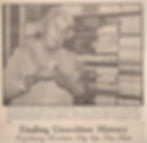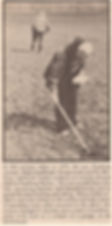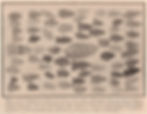- by Karen Cummings
Finding Unwritten History
Come to the Mt. Washington and Saco River Valleys, get away from it all, and enjoy a bountiful life. This conception is what is luring many people to the area now, what lured the early settlers in the 1700s, and what may have lured the earliest inhabitants of the Valley, the Native Americans, as many as 10,000 years ago.

Though many residents give little thought to the original residents of the beautiful, and at one time bountiful, valley, it comes as no surprise to many farmers, rockhounds, and to Helen Leadbeater and Eve Barbour of Fryeburg that this area was once home to traveling groups of Native Americans. They all have tangible proof of the Indian's presence--collections of artifacts ranging from perfectly formed arrowheads, pieces of decorated pottery, and many examples of the everyday tools of the earlier inhabitants.
For farmers, finding troves of the long gone Native American population is as easy as walking through a newly plowed field. Turning over the soil brings buried items to the surface, and if the item hasn't been too badly mangled by the plow, it immediately stands out as something foreign to the untrained eye without the necessity of searching for it. Over the years, many farmers have just picked up and brought home their findings and taken for granted the fact that Indian artifacts are scattered throughout the Valley. Others just don't bother with them and continue to let them lie where they are.
The mineralogists--referred to as rockhounds--are, of course, always looking for rocks of any sort. Those brought to the area (many of the rocks used for tools by the Indian artisans were not indigenous to this valley) and shaped by the Indians, stand out to their excperienced eyes.
Helen Leadbeater and Eve Barbour's extensive collections of Indian artifacts came about in a more directed sort of way. Neither of these women are native to Fryeburg or the area, but both have taken an extensive interest in the history of their adopted town and its environs. "The newer people seem more interested in the history of the town," said Mrs. Leadbeater, a direct descendant of one of Fryeburg's early settlers who has also been a resident since 1939. "I guess it's the sort of thing that develops when you move into a place."
"History and archeology are two different things," explained Mrs. Leadbeater, "but all this started because I was interested in history." A 1934 graduate of Swarthmore as a history major, Mrs. Leadbeater moved to Fryeburg when she inherited one of the town's more famous houses, the Squire Chase house on Main Street. Starting her investigations with the history of her new home, Mrs. Leadbeater advanced to studying the past of the whole town after taking a position as the librarian in the Fryeburg Women's Library. "People would write or come in and ask questions, so I did a lot of research into the local history," she said.

Not one to do things half-heartedly, Mrs. Leadbeater studied Fryeburg history extensively. Feeling she had a good grasp on the details of the town's past, it is easy to understand her dismay when the state of Maine erected a standard in the center of town with names of historic note in the town, and one of those listed, Nescambouit, escaped her. "He was an Indian who had been knighted by the King of France," she explained, "and I had never even heard of him. I had a vision that all sorts of people would be coming in the library and ask about him. Nobody ever did, though. But I wrote the state library anyway, and they sent me a book of Indian biographies."
This sparked a new interest. "I've always been curious," she said, "so I started trying to find out everything I could about the Valley's Indians." Five years were spent in research, with several trips to Portland gathering information at the library there. All information was carefully typed -- "This was before Xeroxing," she explained -- and filed for future reference. "Everyone assumed I was going to write a book, and I suppose I should," Mrs. Leadbeater added.
Always interested in additional information, Mrs. Leadbeater was amazed to read an article in a newspaper about John Gray, a Fryeburg Harbor farmer, and his collection of Indian artifacts. "It was the first I had heard that there were such things just lying around in the ground," she said. "I immediately got my husband and went up to investigate."
The Saco River once flowed through Fryeburg Harbor before the course of the river was shortened in 1820 and diverted to help prevent spring flooding in the fertile fields. Mrs. Leadbeater arrived on the scene in late spring after high water had receded in the plowed fields. "Water had just gone over the plowed fields and washed the dirt off Indian artifacts all over the place," she said. "Mr. Gray gave us permission to go into the fields and look before he planted them. The sun would shine on the stones -- it's not naturally stony land -- and we found things everywhere." On her first foray into archeology, Mrs. Leadbeater also picked up broken pieces of pottery. "The men weren't interested in that," she said.
It didn't take much to pique Mrs. Leadbeater's interest in the history of the town or the history of the Indians, so the discovery of actual Indian artifacts soon had her learning everything possible about archeology. "I joined the New Hampshire, Massachusetts, and the Maine archeology societies and learned quite a bit from them," she said, "and also got quite a bit of books." She studied and soon was following the proper techniques for digging and cataloguing items found. "Though I did label things that I picked up, I learned it wasn't enough just to lump those things together," she explained. "I learned that if you look at this stuff, even though it is similar, at each one of the sites, there is some difference in the average. The next step is to start comparing things."
Her comparisons have caused Mrs. Leadbeater to agree with several anthropologists who concur that the Fryeburg area was occupied off and on for centuries by Indian villages of fairly small sizes. "Due to their hunting and gathering lifestyle," she explained, "they didn't stay too long in one place."
Mrs. Leadbeater continued to hunt for traces of Indians on her own for many years, enlarging her collection with her own finds and those of others who knew of her interest. Most of her finds were surface finds, and these occurred almost everywhere she went -- even at her favorite swimming place on Lovewell's Pond.
In 1969, she learned of the uncovering of a site in Fryeburg Center which, through her research, she considered would prove fruitful. A house on Corn Shop Road was being moved and the topsoil of the front yard had been removed, revealing what was once the sandy bank of Bear Pond -- a body of water which had disappeared when the Saco River course was changed.
Approaching her friend and neighbor, Eve Barbour, who also had an interest in history, Mrs. Leadbeater urged her to join her in a "dig" at this prime site. "I had never given any thought to the Indians or that you could find that kind of stuff," said Mrs. Barbour, "but once you've found your first flake [the pieces that are chipped off when the Indians formed their tools] you are hooked."
The two women took every opportunity to search for artifacts. "For a few years, it seemed like we devoted our lives to it," said Mrs. Barbour. The methods of the two women differed -- Mrs. Leadbeater followed the advice of the books and dug carefully, slowly, sifting everything, while Mrs. Barbour would attack the site with a shovel much to the horror of her companion. They were ecstatic to find evidence that Indians had camped right on the very spot they were digging. "We found a lot of pottery, flakes, arrowheads," said Mrs. Barbour. "Using a probe, my husband found a stone ax about 15 inches down."

Much time and effort was devoted to finding the plentiful artifacts. "Digging for things is hard work," said Mrs. Barbour, "but we'd go out in the hot sun, or sit in the car to wait out a thunderstorm, just to spend time looking." One of Mrs. Barbour's best examples of pottery might have been even more complete if an oncoming tractor hadn't forced her to give up the search. "He was heading right toward me," she said, "and definitely thought that what he was doing was more important that what I was doing."
The two women have extensive collections with Mrs. Leadbeater's filling more than one room in her large home. Examples of pottery are obviously of different eras with decorations and style varying from the primitive cord wrapped stick design on thick pottery to more sophisticated rocker dentate and incise patterns on beautifully shaped pieces. Opening boxes and boxes of her collection to illustrate the different styles, Mrs. Leadbeater can remember the circumstances of each "find." Both women have catalogued much of their collections although Mrs. Leadbeater, who has been collecting for more than 30 years, has been unable to get to the many flakes of rock, pieces of pottery, scrapers, gouges, and arrowheads that are stored in cardboard egg cartons in a room devoted to her collection.
The efforts of the two women have not gone unnoticed by archeology experts in the state. Two of their most complete examples of Indian pottery are on display at the Maine State Museum in Augusta. Michael Gramly, an anthropologist/archeologist, has looked at both collections and determined some of the pieces to be as old as 1500 to 2500 years. Gramly was active in the paleo-Indian site in northwestern Maine, the Vail site at Aziscoos Lake near where Maine, New Hampshire, and Quebec share borders, that archeologists have determined to be 11,000 years old. "He was very interested in the things we had collected," said Mrs. Leadbeater, "but got a better job offer in Buffalo before he could do anything about it."
Others who have shown interest in the collections have also moved on to different areas, leaving both Mrs. Leadbeater and Mrs. Barbour still curious. "An interest in archaeology sort of grows on you," said Mrs. Leadbeater. "I want to know who these Indians were. Were they always the same people? I want to know how long they lived here, if it was their descendants who returned each time. I want to know how long ago they were here. Right now it's all still lost history."
NOTE: This article in the Conway Daily Sun provides more information -- Tom McLaughlin: Limits of history | Columns | conwaydailysun.com.
